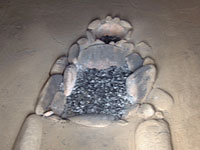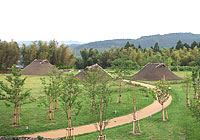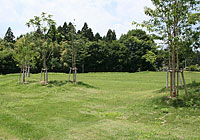- HOME
- About
About Sendai City Jomon Site Park
Relive Jomon spirit and skills still relevant today
 Sendai City Jomon Site Park is a facility that conserves and makes use of the Jomon period village ruins discovered in the 'Yamada-Uenodai Site' located in Taihaku Ward, Sendai City.
Sendai City Jomon Site Park is a facility that conserves and makes use of the Jomon period village ruins discovered in the 'Yamada-Uenodai Site' located in Taihaku Ward, Sendai City.
Outside there is a Jomon village with reconstructed pit dwellings and storage pits, and there is an open plaza where earthenware was made and plants were cultivated. It is surrounded by a forest arranged with ko-nara (quercus serrata) and chestnut trees, and a Jomon period village has been recreated together with the surrounding environment.
Related links
Guidance Institution
Yamada-Uenodai Site
The Yamada-Uenodai Site were discovered during an excavation survey to build a housing estate in 1980.
As a result of the survey, compound site were found. The area had been used as a living place and graveyard from the Paleolithic period to the Jomon, Heian and Edo periods. Discovered Jomon period remains date from the end of the middle Jomon period, approximately 4,000 years ago. The Jomon village was of a large scale. 38 pit dwellings, over 380 storage pits and animal trap pits, and over three dumping sites were found.
This led to plans to conserve and make use of the ruins, and so the Jomon Site Park was built. The facility was eventually opened on 15th July, 2006.
Jomon village
During the excavation survey, 38 pit dwellings, pits for storing nuts, and pitfalls for hunting animals were found. The dwellings were divided into east-west groups on the edge of a plateau with a good view of the surrounding areas. Inside that area was believed to be an open plaza.
On the east side, three pit dwellings that we know were built in the same period have been reconstructed. In the surrounding area; storage pits, animal trap pits, and disposal mound are displayed above-ground, and a Jomon period village has been recreated.
Pit dwelling and storage pit relics have also been recreated.
Dwelling pits
 ▲ Reconstructed pit dwelling (No.9 dwelling)  ▲ Cross sectional view  ▲ Reconstructed 'fukushiki-ro' fireplace |
Three dwelling pits have been reconstructed. In the reconstruction, the findings of another site survey were referenced to make the soil roof type structure, which has soil applied on top of a roof built on a chestnut frame. Each of the pit dwellings was built by first digging a depression in a circular shape and then flattening the floor, upon which beams were erected to support the roof. On the south side of the floor, which lied in the direction of the entrance, there was earthenware surrounded by pebbles and a large-size fireplace called a 'fukushiki-ro' constructed from an arrangement of large riverbed stones. |
Jomon open plaza
  |
The west site contains a place that was an open plaza in the Jomon period. This area has a Jomon-style farm, where people of that period grew crops, and it is also used as a place for excavation surveys combined with workshops. Beyond that a Jomon period forest has also been reconstructed together with a village and open plaza. Previous research has found that there was once a forest abundant with deciduous broad‐leaved trees similar to modern-day copses nearby the Jomon period village. To recreate this, trees including chestnut, walnut, Japanese horse-chestnut and ko-nara and shrubs comprising the Japanese angelica tree , linden arrow-wood were planted along with herbaceous plants made up of bamboo grass, cogon grass , and Japanese bellflower. In this forest, dozens of chestnut trees were planted together to make a chestnut grove near the pit dwellings. Also, a variety of tree types were planted to create a copse on the western side of the open plaza. |
Management and operation
This has been conducted by the Sendai Cultural Foundation, which was designated as the museum manager by Sendai City for a five year period from 2017 to 2021.
